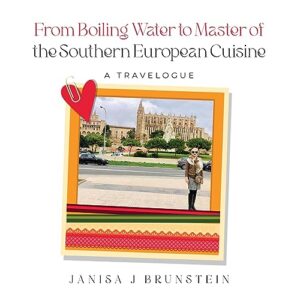Title: From Boiling Water to Master of the Southern European Cuisine
Author: Janisa J. Brunstein
Publisher: Author Reputation Press
ISBN: 979-8888533529
Pages: 222
Genre: Cooking / Travel
Reviewed by: Dan MacIntosh
Hollywood Book Reviews
Janisa J. Brunstein’s book, From Boiling Water to Master of the Southern European Cuisine, includes a lot of different subjects rolled into one. We learn two undeniable truths about Brunstein from reading this book, however, number one, she loves to cook and eat. Number two, she loves to travel. So, if you seek to learn more about the food and geography of Southern Europe, you’ll find plenty of information about these two fascinating topics within.
One thing the reader doesn’t really learn, though, is if and when Brunstein went from ‘boiling water to becoming a master of Southern European cuisine.’ A title like this strongly suggests that Brunstein went from being someone who couldn’t really cook – and only able to do little more than boil water – to a master chef. It’s a wonderfully intriguing book title, but Brunstein doesn’t support it with what follows. Had she called this book something like ‘food and culture from around the world,’ well, that would have made much more sense. Nevertheless, don’t let this quibble about the book’s name deter you from reading it. Brunstein knows her food and her world map, and she brings all her fun explorations to life.
One is left with the impression Brunstein wrote this book for readers who also enjoy cooking, like her. She has included so many different recipes at the end of various chapters. These inclusions are helpful, especially for many of us that can’t afford to travel around the world eating tasty foods. Not all of these recipes are European finds, either. For instance, at the book’s beginning, Brunstein provides directions on how to make some of her favorite Christmas and Valentines Day dishes.
In addition to colorful recipe layouts, Brunstein also includes pictures of the scenery she encountered on her trip. Additionally, she includes pictures of herself enjoying this trip. These shots seem to be saying, ‘It really is a kind of foodies’ dream vacation. She’s fit and trim, too. With some of our luck, we’d probably come home the size of a Goodyear blimp. Then again, she encloses a recipe for Caesar salad along with her other Italian food dishes, and you can’t really go too wrong with salad, right?
What makes Brunstein’s travelogue so believable, is her utter honesty. For instance, if she visits a foot market – although stocked with good items – some of which are smelly, she’s not afraid to say so. Granted, this honesty is not exactly hard news. However, readers will appreciate her candor, especially those who may want to follow in her footsteps, if you will, and plan a similar trip.
There are plenty of types of escapism known to mankind. Some are healthier than others. Exploring world foods is certainly one of the safer escapes. Better, by far, than, say, falling into drugs or some dependency. If you’re not a self-described foodie, much of this book may go over your head. If that’s you, a non-foodie, you may say, ‘Why so much ado about what’s for dinner?’
However, if you love food, and you’re on a seemingly constant quest to know all of what the world likes to eat, this book will add much to your knowledge about all things food-related. We still want to know the full story about how Janis J. Brunstein discovered and learned how to cook well. Maybe that’s for another future book. For now, though, read this work and get really global with your eating habits.

